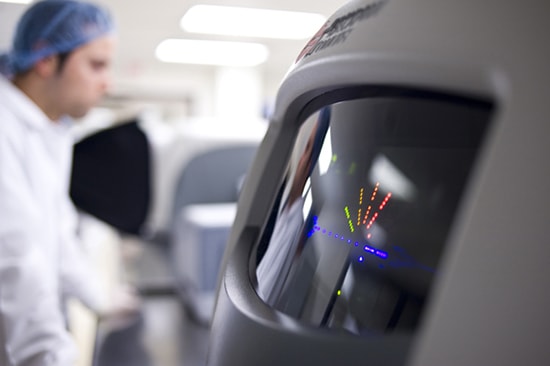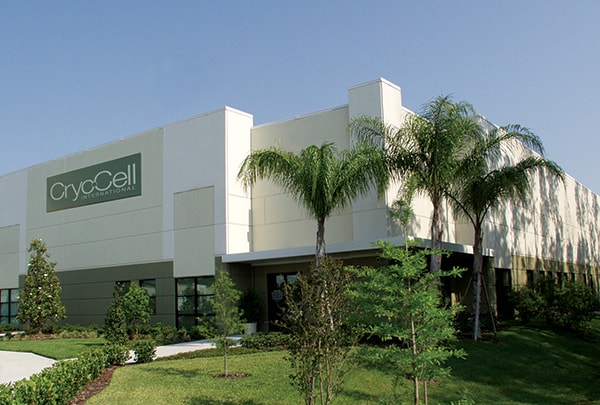Pregnancy is no easy task. There’s a lot to do, and a lot to deal with. One of the more time-consuming aspects is all the research that needs to be performed on everything from the best car seat to the right pediatrician.
Cord blood banking is a hurdle upon itself. Often expectant parents need to learn what cord blood banking is and why cord blood banking is important, and then it’s time to determine which cord blood bank is best for them.
There are many things to consider when deciding which is the best cord blood bank. The number of years it’s been in business, its level of certifications and accreditations, and the type of processing method(s) available should all come into the decision.
One often overlooked aspect is whether the cord blood bank has an in-house, on-site laboratory or it outsources all its lab work to a processing lab.
What goes into a cord blood lab?

Machines to analyze cord blood are a large investment for cord blood labs
There is a lot that goes into a laboratory that handles and stores cord blood. Firstly, it needs to be built to endure the elements including the effects of hurricanes, tornadoes, earthquakes and other natural disasters.
It also should be self-sustaining and able to maintain its own power and cryogenic chambers without outside assistance for an extended period of time.
Secondly, to comply with FDA regulations and obtain accreditation from AABB and FACT, clean rooms for the cord blood and cord tissue processing need to be established and maintained to standards set forth by the International Standards Organization (ISO). For instance, ISO standards require the number of particulates of certain micron sizes in any cubic meter of air not go over specific levels.
To ensure the room’s cleanliness, gowning rooms and procedures need to be established, and special air conditioning systems that monitor the particulate levels, air pressure, humidity and temperature need to be installed. In addition, access to the laboratory’s clean rooms (and cord blood and tissue collections) needs to be controlled and limited to required personnel.
Thirdly, audits need to be performed on a regular basis, and all protocols need to be assessed for effectiveness periodically. This includes inspections by the FDA, the state's health department and established outside accreditation firms such as the Foundation for the Accreditation for Cellular Therapy (FACT) and the American Association of Blood Banks (AABB).
In-House versus outsourced cord blood labs
There are basically three types of laboratories a cord blood bank can have. One is an in-house, on-site lab. This is where the laboratory is maintained within the same building or on the same premises as the main headquarters of the cord blood bank’s administration.
The second type of cord blood lab is one maintained by the cord blood bank but located off-site and not near where the other duties of the cord blood bank are performed.
The third type of lab for a cord blood bank is one that is contracted by the cord blood bank to perform the laboratory duties.
Let’s look at how all three types of labs compare in regards to specific areas of concern.
| |
In-House Lab |
Outsourced Lab |
| Cryo-Cell |
 |
|
| Cord Blood Registry |
 |
|
| Viacord |
 |
|
| AlphaCord |
|
 |
| Americord |
|
 |
| Family Link |
|
 |
| Maze |
|
 |
| SafetyCord |
|
 |
Financial stability

Cryo-Cell's headquarters features a state-of-the-art cord blood and cord tissue lab.
Cord blood banks that outsource their lab work, in a way, have not fully invested themselves in the cord blood–banking business. This could be due to cash flow concerns or the inability to properly fund a working laboratory. For expectant parents, this may be a warning sign about the financial stability of a cord blood bank.
In addition, cord blood banks that contract with processing labs are never sure if the lab is financially stable and must be prepared to change labs (and move any stored collections) if the lab were to go out of business.
If the lab is unable to procure a profit under the contract it has with the cord blood bank, it may raise its rates dramatically when it comes time to renew any contracts. The cord blood bank would then have to raise its collection and storage fees to offset the additional costs.
Having an in-house lab shows how much the cord blood bank has invested in the cord blood–banking business and its customers' welfare. The cord blood bank is always there to ensure the financial stability of the lab and maintain consistency in pricing year after year.
Payment handling
Parents should also be concerned about how their payments will be handled. Cord blood banks with processing labs contract the lab work and storage for a certain number of years and pay fees for processing and storage on an on-going basis. If a client signs up for a long-term plan, like a 21-year storage plan, he or she pays the cord blood bank for the entire 21 years upfront, but the cord blood bank does not pay the lab for the 21 years in whole. It takes the client’s money basically with the promise that it will hold it and pay the processing lab piecemeal for the continued storage. If the cord blood bank were ever to shut down and stop paying the lab its storage fee, the lab with the stored cord blood would be looking for the client or someone else to pay for continued storage even though the client already paid for 21 years.
Oversight

Careful analyses are required at all levels in a cord blood lab
The best private cord blood banks know the value of maintaining control of their processes through an in-house laboratory. It gives them the ability to directly manage the quality of the lab and ensure it is meeting internal standards and the standards of outside accreditation firms and the government.
A lab on the same premises as the rest of the business provides direct oversight into how the lab is managed and a direct link between the lab and any quality assurance department as well as the rest of the business.
With off-site labs, there can be a level of disconnect between how the cord blood banks want the labs to be run and the procedures the labs have in place. In addition, immediate consultation with quality control supervisors might not be available.
This disconnect only widens with outsourced processing labs. These labs have their own procedures and standards in place, and the cord blood bank must agree to much of what the lab sets forth including prioritization of workload.
Accreditations
With on- and off-site in-house labs, established outside firms such as FACT and AABB inspect the business in a holistic manner. They look at business procedures for the how the cord blood and tissue collection is handled before it arrives at the lab including the instructions for how the cord blood is to be collected, how the cord blood kit is to be delivered and transported and what, if any, temperature controls are in place.
Unfortunately, these standards are not in place for cord blood banks that outsource their cord blood and cord tissue processing. Often cord blood banks with outsourced labs are not accredited themselves, and it may only be the outsourced lab that the cord blood bank is using that is accredited. These cord blood banks will often refer to having an AABB-accredited lab but not AABB accreditation; it also may refer to itself as AABB-compliant, which is not AABB-certified or -accredited.
Without certification, everything from how they handle customer records to how they treat their collection kits are not beholden to standards except the minimal ones set by the FDA.
Conclusion
There is a lot that goes into an efficient and clean cord blood lab. This requires an incredible investment by cord blood banks, but it is ultimately best for expectant parents who want to bank their baby’s cord blood and cord tissue.
Cord blood banks with in-house labs that are more thoroughly vetted by outside accreditation firms offer the best assurance that the proper steps in handling the cord blood and cord tissue are being taken. Cord blood banks with in-house labs are more stabile, and there is never any worry that the laboratory side of the business will suddenly need to raise the rates for processing and storage. In addition, parents who choose a cord blood bank with an in-house lab don’t have to worry about how their money is being handled as it comes to long-term storage of their baby’s cord blood and cord tissue.
All together, there are many reasons why it is better for expectant parents to choose a cord blood bank with an in-house, on-site accredited laboratory over a cord blood bank that hires an outside laboratory to process and store the baby’s cord blood and cord tissue.
Remember: In this respect, you can really you get what you pay for.
Click below to learn about Cryo-Cell's headquarters and state-of-the-art laboratory.